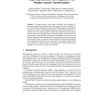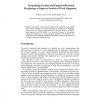71 search results - page 1 / 15 » Improving Statistical Word Alignments with Morpho-syntactic ... |
109
click to vote
ACL
2009
14 years 10 months ago
2009
Often, Statistical Machine Translation (SMT) between English and Korean suffers from null alignment. Previous studies have attempted to resolve this problem by removing unnecessar...
FINTAL
2006
15 years 4 months ago
2006
Abstract. This paper presents a wide range of statistical word alignment experiments incorporating morphosyntactic information. By means of parallel corpus transformations accordin...
120
click to vote
AMTA
2004
Springer
15 years 5 months ago
2004
Springer
German has a richer system of inflectional morphology than English, which causes problems for current approaches to statistical word alignment. Using Giza++ as a reference implemen...
140
click to vote
AMTA
2004
Springer
15 years 5 months ago
2004
Springer
Abstract. An adaptable statistical or hybrid MT system relies heavily on the quality of word-level alignments of real-world data. Statistical alignment approaches provide a reasona...
100
Voted
AMTA
2004
Springer
15 years 5 months ago
2004
Springer
In conventional word alignment methods, some employ statistical models or statistical measures, which need large-scale bilingual sentencealigned training corpora. Others employ dic...


